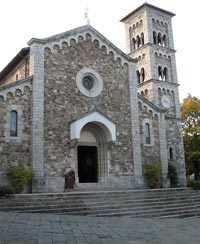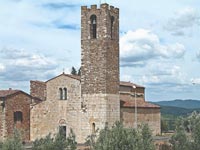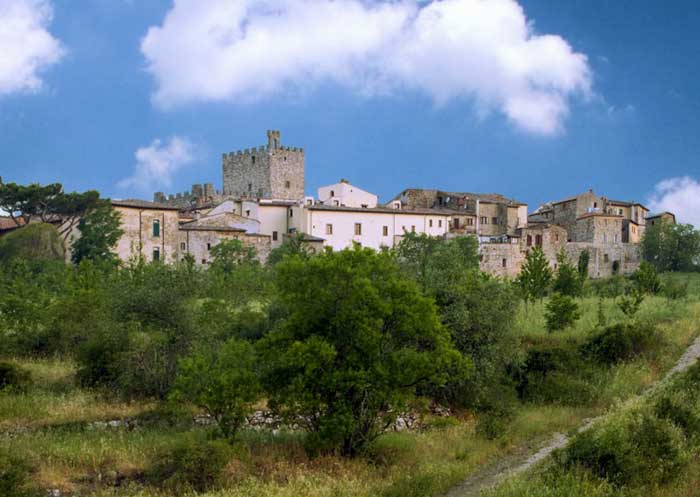 |
|
| I T | Castellina in Chianti
|
Castellina in Chianti |
Castellina in Chianti is situated on a ridge along the Chiantigiana highway between Florence and Siena. The municipality of Castellina is entirely within the Chianti Classico wine zone. Castellina has an attractive old town centre marred by a grotesque formation of industrial silos and an abandoned warehouse, the latter scheduled to be re-developed or demolished at some future time. There is an intriguing covered road inside the town wall and Etruscan tombs in the vicinity. Information Offices - Castellina in Chianti | Centro Servizi Turistic | Via Ferruccio 40
|
| Rocca Comunale of Castellina |
|||
| At the beginning of 15th century the town was transformed in a fortress, of which today remains the impressive Rocca. The Rocca is a massive building located in the main square with a fourteenth-century crenellated keep, from which you can enjoy a wonderful view. The main features of interest in this 15 C fortress, now the town hall, are the atrium, the council chamber, the Captain’s hall, and the courtyard and well. The Rocca, from April 21st 2006, hosts the Sienese Chianti’s Archaeological Museum. The museum, realized using innovative technologies, presents the history of the whole Sienese Chianti area, including the territories of Castellina, Radda, Gaiole and Castelnuovo Berardenga. Museo Archeologico del Chianti Senese (Archaeological Museum of Chianti Senese.) The Museum is located inside the fortress in Piazza del Comune. Opening Hours: The museum is open from Monday to Sunday with the following time: 10-18.30 Closed on Wednesday. |
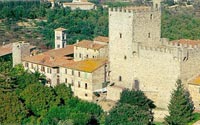 |
||
| Chiesa di San Salvatore |
|||
| Church of San Salvatore, with an early 15th century fresco of Madonna with Child and a polychrome wooden statue of Christ from the same age, was rebuilt and extended after the Second World War, and is in neo-Romanesque style. The left nave contains a 17th century Annunciation of the Tuscan school. |
|
||
| Romanesque church of San Martino, at Cispiano |
|||
| From this church comes from a fifteenth-century bronze Cross ascribed to the Sienese artist Francesco D’Antonio, actually preserved in the parish church of Castellina in Chianti. |
|||
| Church of San Giorgio alla Piazza |
|||
| Church of San Giorgio alla Piazza, housing a 15th panel from Cosimo Rosselli's workshop. It has romanic origin and is certified since 1084, it still has a part of the ancient façade. |
|||
| Palazzo Ugolini-Squarcialupi |
|||
Situated in the heart of the historical center of Castellina in Chianti, one can find the 15th century Palazzo Ugolini, formerly Palazzo Squarcialupi. |
|||
| Via delle Volte |
|||
| The Via delle Volte is a very impressive arched passage leading along the eastern wall, originally an ancient pomerium, a public area of archaic origin adjacent to the walls used for sacred and military purposes. Originally open to the sky, it was gradually covered in by private dwellings built right up against the walls when no longer needed as a defence. | 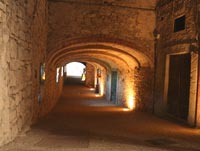 Via delle Volte, a tunnel around Castellina in Chianti |
||
| Montecalvario |
|||
The Etruscan Tumulus of Montecalvario, so called by a small chapel, the last station of the Via Crucis, built on the summit, is a structure of a circular diameter of about 53 meters, made up of four tombs. |
|||
| Fonterutoli |
|||
Fonterutoli was already known in Etruscan times and takes its name from the Latin fons rutolae or fons rutilant (clear spring). It was known as a halting place for food and rest on the road leading from Sienna via Castellina to Florence. |
|||
| Pieve di San Leonino in Conio |
|||
| San Leonino in Conio is a very old parish church that once had control of Castellina in Chianti. Now all that remains is the old Romanesque church, with an interesting interior, a beautiful apse and a small cloistered courtyard. |
|||
| Pieve di Sant'Agnese |
|||
| The parish church of Sant’Agnese, on the main road from Castellina in Chianti to Poggibonsi, belongs to the diocese of Siena. The church has three naves, three apses and an imposing bell tower. The Pieve of Sant'Agnese houses a Madonna with Child by Bicci di Lorenzo. |
|||
| There are other Romanesque churches located in the area, including those of San Cispiano and San Quirico. The former, with its single nave and a small apse, is - like Romanesque churches in the Chianti region - built of typical ivory-coloured Albarese stone. The latter has a single nave, and a bell tower added later on one side. |
|||
| San Donato in Poggio |
|||
San Donato in Poggio is a mediaeval fortified village locatedon a hill (Poggio), from which it takes part of its name. |
|
||
The magistrature, situated in the town square, now known as Piazza Malaspina, was decorated with a XV century fresco, which may still be viewed. The building was reconstructed in large part after damage suffered during the last war. On the other side of the square were the public cistern, which was rebuilt in 1867, and the castle church dating from the XIV century. The late Renaissance facade of the Ticci Palace (which later passed over to the Malaspina family) united the houses and stores to the north and west of the square. Once owned by the noble Ticci and Malaspina families, since the nineteenth century it has belonged to the Pellizzari family. In the village outside the castle, there was a hospital for the poor run by the Augustinian monks, and subsequently run by the St. Maria della Neve confraternity. Around the year 1000, the Pieve di San Donato was constructed outside the walls of the castle. This church is one of the most typical examples of the Florentine Romanesque architecture. It has three aisles terminating in three semi-circular apses, that envelop the pre-existing bell tower. The façade is constructed of squared albarese filaretto, and inside there is a baptismal font in glazed terracotta by Giovanni Della Robbia (1513), a crucifix attributed to Taddeo Gaddi (1300 - 1366, a disciple of Giotto for 24 years). |
|||
| About a kilometre from the Pieve di San Donato stands the late Renaissance sanctuary of Santa Maria delle Grazie a Pietracupa, built close to a tabernacle which housed a Madonna believed to be miraculous. The most remarkable complex of the territory is the Badia a Passignano, founded by the monks of the Vallombrosan order in 1049. Set within a stupendous landscape, the Badia a Passignano appears like a fortified hamlet, dominated by a belltower and surrounded by constructions of different periods. The abbey possesses an exceptionally rich archive (almost seven thousand parchments) and precious works of art: the frescoes by Passignano in the church dedicated to San Michele Arcangelo and above all the Last Supper frescoed by Domenico and Davide Ghirlandaio in the refectory of the monastery.The Sanctuary of Santa Maria delle Grazie is located in Pietracupa and houses important works by Domenico Cresti, known as "Il Passignano", and by Gamberucci. |
|||
Castellina in Chianti borders the municipalities of Barberino Val d'Elsa, Castelnuovo Berardenga, Greve in Chianti, Monteriggioni, Poggibonsi, Radda in Chianti and Tavarnelle Val di Pesa. Fonterutoli, Lilliano, Piazza, Rencine, San Leonino, San Quirico, Sant'Agnese are frazioni of Castellina in Chianti. |
|||
Castellina in Chianti is one of the principal towns in the Chianti wine region north of Siena.
|
|||
Chianti, the area in which Chianti Classico wine has been produced for centuries, is that part of Tuscany that is bordered to the north by the suburbs of Florence, to the east by the Chianti Mountains, to the south by the city of Siena and to the west by the valleys of the Pesa and Elsa rivers. The area is traversed by the Superhighway of the Palio. It is a land of ancient traditions that was civilized in remote periods first by the Etruscans, who left many traces of their activity in the wine sector, and then by the Romans. In the Middle Ages, the cities of Florence and Siena battled for control over the zone. Villages and monasteries, castles and fortresses appeared during that period and many of them were later transformed into villas and country residences when times were more tranquil. It was then that spaces were cleared in the vast forests of chestnuts and oaks for the cultivation of vines and olive trees, an activity that progressively assumed major economic importance and established an international reputation.
|
|||

